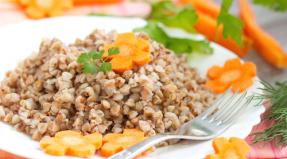What vegetables are low in calories. Calorie content of vegetables, which ones are better to use for diet food
Vegetables play a huge role in the diet. But not every one of them can be suitable for the diet of a person who wants to lose weight, because there are very high-calorie vegetables. In order not to be mistaken, a special calorie table has been developed, where you can see the nutritional value, composition of proteins, fats, carbohydrates of any vegetable.
Calories in fresh vegetables
Vegetable products, when broken down in the human body, release less energy than animal foods, and also contain a sufficient amount of fiber, which creates a feeling of satiety and normalizes bowel function. Therefore, vegetables are a valuable dietary component of nutrition.
Different types of vegetables are perfectly combined with each other, which allows you to create a large number of delicious dishes.
Consider the calorie content of some fresh vegetables, kcal / 100 g:
- Cucumbers - 14
- Zucchini, green salad - 18
- Tomatoes - 21
- Eggplant - 24
- Cauliflower, potatoes, leeks, carrots - 38
- Bulb onion, beetroot - 53
- Green peas - 92
- Garlic - 148
Cucumbers have the least calories, only 14 kilocalories, not much more energy weight in lettuce and tomatoes. In addition, these vegetables are very useful, their daily consumption is recommended.
Garlic contains the most calories, but it is simply impossible to eat enough of it to get better. The most "dangerous" in terms of gaining extra pounds is green peas, so do not get carried away using it.

Not always the calories in fresh vegetables can be a useful indicator, since some of these foods are not eaten raw, such as eggplant or potatoes.
It is very important to remember that the calorie content of fresh vegetable salads is more dependent on the dressing. Therefore, if you season even the most low-calorie vegetables with mayonnaise or fatty sauce, then this will no longer be a dietary dish.

Properties of boiled vegetables
The food system contains vegetables that have undergone heat treatment. Dieters are advised to eat steamed, boiled, stewed vegetables. Although cooked, they lose a number of vitamins, their calorie content increases, but such products are easier to digest, their taste improves, and some vegetables cannot be consumed raw at all.
To find out how many calories are in boiled vegetables, you can use calorie tables or special calculators. But we can say that boiled vegetables, in comparison with fried ones, have a much lower energy value, so they are dietary.
For example, salad "Vinaigret" without dressing has a calorie content of up to 95 kilocalories, which summarizes the calorie content of all vegetables used for cooking. So, the caloric content increases not critically.

To improve the taste of boiled vegetable dishes, you can add various aromatic herbs, they will not increase calorie content, garlic, hot peppers. You can cook stews from several types of vegetables, this dish allows you to change the recipe, making combinations of products to your taste and desire.

Frozen vegetables - properties
If you want to eat vegetables that retain all the nutrients, and the season for fresh ones has long passed, then frozen vegetables can be a great alternative.
Freezing is practically the only preservation method capable of preserving almost all the nutritional characteristics of a fresh product. There is no loss of vitamins and other nutrients. The calorie content of vegetables does not change either, and if there are changes, they are so negligible that they can be neglected.

No one doubts that vegetables are the most useful and dietary human foods. It is impossible to imagine a single diet, wherever they are present. Eating vegetables provides the body with essential nutrients and ensures its normal functioning.
Video Compilation
Wanting to get rid of extra pounds, sooner or later, each person approaches the issue of a balanced diet. Vegetables will help to diversify the menu, satisfy the feeling of hunger and provide the body with vitamins. Their low calorie content, the presence of a large amount of fiber contribute to improved digestion and allow you to achieve a feeling of satiety.
Of course, the nutritional value depends on the method of preparation. Steamed products are considered the most popular for weight loss. Such dishes are dietary and will not harm the figure at all. In addition, British scientists have proven the relationship between proper nutrition and life satisfaction. Do you want to be slim and happy? Diversify your menu with low-calorie steam-cooked vegetable dishes. The fact is that they retain almost all vitamins and nutrients, and low energy value will help satisfy hunger without adding a single gram to your weight.
In order to find out how many calories steamed vegetables contain (carrots, cabbage, beets, etc.), it is not at all necessary to independently calculate the energy value of each product. It is enough to go to our website, which presents a table that lists the calorie content of steamed vegetables and correctly compose your menu.
The calorie content of vegetables shows how much energy they give the body when eaten. Vegetables are an important part of the daily diet and a source of fiber, vitamins and minerals.
Fresh vegetables calories
The calorie content of vegetables is important to know for overweight people who want to lose weight. Compiling a calorie diet takes into account all the components of the diet. Calories in vegetables are most often calculated per 100 g of food weight. Now you can find different options for online calculators that allow you to calculate the required daily caloric intake depending on gender, initial and desired weight, occupation and age, as well as find out how many calories are in the vegetables of a particular dish.
It is known that plant foods are less caloric compared to animal products. This makes vegetables a valuable dietary product. Separate vegetable crops can be combined in a variety of ways, which allows vegetable salads for weight loss to become the dish that diversifies the daily diet.
Some examples of the calorie content of fresh vegetables (kcal per 100 g of product):
- Eggplant - 24;
- Green peas - 72;
- White cabbage - 28;
- Potato - 83;
- Onions - 43;
- Carrot - 33;
- Cucumbers - 10;
- Sweet pepper - 27;
- Parsley greens - 45;
- Radish - 20;
- Tomatoes - 15;
- Salad - 14;
- String beans - 32;
- Garlic - 106.
The calorie content of vegetables can sometimes be quite high, they primarily include legumes (peas, beans, beans) and starchy vegetables (for example, potatoes). They can be included in the diet on a diet only periodically, replacing them with other high-calorie meals. Watery vegetables are the lowest calorie (for example, cucumbers, tomatoes), they are recommended to be consumed daily. Vegetable salads for weight loss of them, among other things, are valuable for containing structured water.
It is important to remember that the calorie content of vegetable salad is affected by what it is seasoned with. Mayonnaise, fatty sour cream or sauce significantly increase the calorie content of vegetables, so for people on a diet, it is best to dress the salad with vegetable oil (sunflower, olive, etc.) or, even better, lemon juice.
Calorie stewed vegetables
 In addition to fresh vegetables, thermally processed are always present in the diet. For those people who follow a low-calorie diet, vegetables are recommended to be boiled or stewed. Heat treatment makes it easier to digest many of them, although a number of useful vitamins and other biological substances are destroyed. But stewed vegetables create a feeling of fullness and at the same time retain a low calorie content. So, the calorie content of vegetable vinaigrette salad is only 92 kcal per 100 g. You can improve the taste of stewed vegetables with herbs and vegetables - basil, garlic, onions, thyme, etc.
In addition to fresh vegetables, thermally processed are always present in the diet. For those people who follow a low-calorie diet, vegetables are recommended to be boiled or stewed. Heat treatment makes it easier to digest many of them, although a number of useful vitamins and other biological substances are destroyed. But stewed vegetables create a feeling of fullness and at the same time retain a low calorie content. So, the calorie content of vegetable vinaigrette salad is only 92 kcal per 100 g. You can improve the taste of stewed vegetables with herbs and vegetables - basil, garlic, onions, thyme, etc.
Vegetable dishes are tastier when they are combined with each other, for example, in the form of vegetable stew. It can be consumed both as an independent dish and as a side dish. The calorie content of stewed vegetables will be summed up from the calorie content of individual products in its composition - potatoes, green peas, tomatoes, cauliflower and sweet red peppers. If desired, the list of ingredients can be supplemented or changed. It is also useful to eat cabbage more often - even in stewed form, it is a rich source of vegetable protein, vitamin C and dietary fiber (fiber), which improves bowel function.
The calorie content of vegetables makes it possible to include them in the diet of obese patients every day without worrying about weight gain.
In accordance with the principles of healthy eating, vegetables should make up a third of a person's daily diet, and for vegetarians and adherents of plant foods, this figure can increase considerably. With an assortment of vegetables that grow in gardens and vegetable gardens, and also appear on the shelves of grocery stores, the question of menu diversity disappears immediately: combinations and creation of various dishes are limited only by your own imagination. But the main thing is that vegetables are famous not only for their nutritional value: they have long been noted as natural healers in all countries. Moreover, unlike chemical medicines, they do not require additional support for immunity or the removal of excess elements that settle in the liver or strike at the cardiovascular system. Therefore, they can be considered practically harmless, although, of course, they have some points that should be taken into account so as not to harm yourself.
Due to such wide distribution and active consumption, everyone who monitors their diet should know how many calories are in vegetables, how they are distributed according to energy value, how they affect the body, how to properly cook vegetables in order to preserve all their useful properties and offset the negative ones. And in addition, find out whether it is possible to lose weight on vegetables, and whether it is reasonable to eat them constantly.
How many calories in vegetables
There is no average figure for the calorie content of vegetables, since with all their diversity it is difficult to give out any one value. And for the same reason, it is not possible to analyze in detail absolutely everyone. But it is permissible, by dividing into groups, to compile a table of calorie content for vegetables, considering, if not all available on the globe, then at least the most commonly eaten. Of course, there are a great many classifications for this category of products: they can be divided according to anything, up to color. In descriptions of diets, for example, very often there is an indication of non-starchy vegetables, or especially fortified with protein. But to consider them for calorie content, it is better to use the one that divides them according to the most obvious signs. It is worth first bringing the entire list, and then studying each category, so that in the end you can clearly understand which specific vegetables from the calorie content table are best for lunch, and which ones you can safely have a snack before bedtime.
By and large, only two groups of vegetables are distinguished: vegetative and fruit, but a more detailed breakdown is required for consideration for calorie content, and therefore the distribution in the vegetable calorie table will be immediately divided into subcategories included in the main groups.
1) Tubers. Not the most numerous category, which includes Jerusalem artichoke, sweet potato and potatoes. The last representative of this subgroup is most actively used for food, by and large replacing bread in the cuisine of the Slavic peoples. From the point of view of the calorie content of a vegetable, perhaps it will be lighter than bread, and from the point of view of its chemical composition, even more useful. True, given the complexity of its digestion and a certain heaviness present after consumption, it is recommended to leave it for lunch, not including it in recipes for dinner. As for the calorie content of vegetables that are part of the tuber subgroup, the lightest is the sweet potato, called sweet potatoes, but in fact resembling the latter only in the form of tubers. The calorie content of sweet potato is 60 kcal per hundred grams. It is followed by an "earthen pear" - Jerusalem artichoke - with a calorie content of 62 kcal per hundred grams. And the potato closes the top three, whose calorie content is the highest - 77 kcal per hundred grams.
2) Root crops. This is perhaps almost the most "densely populated" subgroup, which includes a dozen different vegetables. Carrots, turnips, radishes, beets, radishes, rutabagas, parsley roots, celery and parsnips. All of them grow in gardens and orchards, and therefore there are no problems with the availability and understanding of these representatives of root crops. Their calorie content basically floats in the range from 20 kcal to 51 kcal per hundred grams, and therefore will have to be indicated separately for each vegetable.
The calorie content of radishes is perhaps the most insignificant and is 20 kcal per hundred grams; in addition, it has a good effect on metabolism and the digestive system, and therefore it is often recommended for use in diets. For daikon - an Asian radish - the figure will be 21 kcal, but for classic black and green it will increase to 36 kcal and 32 kcal, respectively. Turnips with a calorie content of 32 kcal, carrots with a calorie content of 35 kcal, and swede with a calorie content of 37 kcal can also be called quite light. Not much ahead of them in terms of "weight" beets - 42 kcal, as well as the roots of parsley, celery and parsnip - 51, 34 and 47 kcal for each.
3) Onion. There are not many “faces” here, but they are all indispensable in the process of losing weight, as well as for the immune system. Onions "weigh" only 41 kcal, leeks - 36 kcal, shallots - 72 kcal, but garlic is all 149 kcal. But in the case of the latter, it makes no sense to be interested in how many calories are in a vegetable, and then worry: it is not so much used in food, and the properties in the field of nutrition overlap any values.
4) Fruit. Along with root crops, this is the largest group, in which there are many representatives and subgroups. The most famous are tomatoes, cucumbers, eggplants, zucchini, pumpkin, squash, peppers, artichokes. It is they who most often end up on the table, both as a side dish and as an independent dish: for example, vegetable stew. They are served fried, baked, steamed, stewed. The calorie content of vegetables in the last two options is the lowest if fats in the form of butter or mayonnaise are not added to them. Then it is even able to decrease in comparison with the value for fresh products. For example, for tomatoes, eggplants and zucchini, the raw indicator is 19 kcal for the first and 24 kcal for the rest. While for the same vegetables, the calorie content in stew will already be 16 kcal for tomatoes, 23 kcal for zucchini and 26 kcal for eggplant. If oil is added, the calorie value for stewed vegetables naturally increases.
The remaining representatives of the fruit group also vary quite a lot in fresh calorie content. Cucumber - 14 kcal, pepper - 26 kcal, patisson - 19 kcal, pumpkin - 22 kcal, artichoke - 28 kcal.
Cabbage also belongs to the fruit group, and the calorie content for the most familiar of all, white cabbage, is 35 kcal, broccoli - 34 kcal, and cauliflower - 30 kcal. In beans, which belong to the legume subgroup, the calorie content reaches 298 kcal, but given its high satiety and protein content, which it can even compete with meat, every calorie from a vegetable is justified.
The harm and benefits of vegetables
 Unlike other food groups, vegetables are quite loyal to any state of the body. They are more likely to heal than to cripple, but at the same time they still have some reservations in their use. In particular, eggplants and beans are never eaten raw, potatoes should be limited in the daily amount due to the load on the pancreas, and beets have a laxative effect. And, as with any product, there are individual intolerances to vegetables too.
Unlike other food groups, vegetables are quite loyal to any state of the body. They are more likely to heal than to cripple, but at the same time they still have some reservations in their use. In particular, eggplants and beans are never eaten raw, potatoes should be limited in the daily amount due to the load on the pancreas, and beets have a laxative effect. And, as with any product, there are individual intolerances to vegetables too.
But you can write a whole treatise about the benefits of vegetables, since it is difficult to fit not only in one sentence, but also in one page. Each of them has pronounced qualities in a certain area, but in general, a group of vegetables affects absolutely all body systems from cardiovascular to reproductive. And a high proportion of fiber is very much appreciated during the process of losing weight and trying to improve digestion, as a result of which the eyes are usually closed on the calorie content of vegetables, because there are much more positive aspects than the possible harm from such insignificant numbers.
4.9 out of 5 (7 Votes)



















